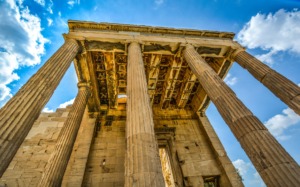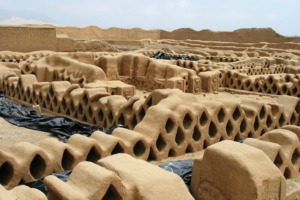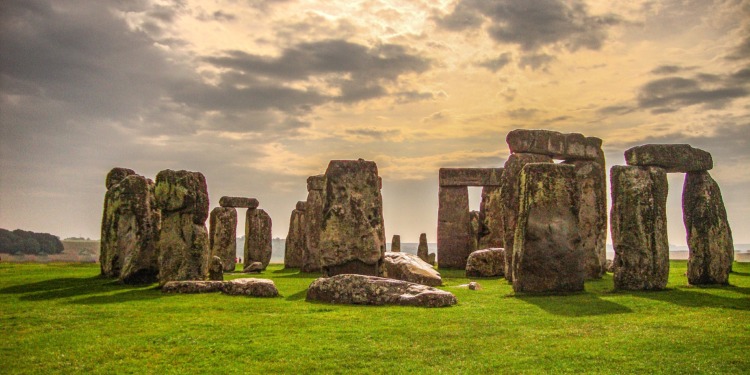Many World Heritage Sites – locations deemed worthy of preservation in light of their “universal value to humanity” – have lasted for centuries, and some for millennia. However, for a number of these areas it seems time may be running out as climate change poses a new and unprecedented threat.
There are over 1,000 sites that have received World Heritage status, including the Great Wall of China, the Tower of London, Stonehenge, and the Acropolis of Athens.
One of the key reasons these areas are recognised and deemed to be so significant is their historical value as remnants of bygone eras. However, they also play fundamental roles in the economies of the countries they are situated in. Machu Picchu, for example, reportedly generates around $35 million each year for Peru.
Tragically, though, the impacts of climate change – including sea level rise, heatwaves and wildfires, flooding, coastal erosion, and pollution – have already caused irreparable damage to a number of sites, and are predicted to pose progressively greater threats in the years to come.
The following are three case studies that exemplify the variety of natural and cultural sites at risk:

The Great Barrier Reef
The Great Barrier Reef is one of the seven wonders of the world and amongst the 46 marine World Heritage sites. It spans over 2,300km and contains the world’s largest collection of coral, as well as a remarkable amount of biodiversity.
The health of our oceans has been a popular topic recently, with documentaries like “Seaspiracy” – which made it into Netflix’s “top 10” in 32 countries – drawing attention to the devastating impact of plastic pollution and the mass fishing industry on marine life.
However, whilst commercial fishing is doubtlessly a point for great concern, it is climate change that is currently presenting the largest threat to the reef.
In fact, the reef lost half of its coral cover between 1985 and 2012 due to what the Great Barrier Reef Foundation describes as a “perfect storm” created through the combination of four factors:
- Coral bleaching: When under heat stress, corals expel the microscopic algae inside their tissues, revealing their white skeletons. Corals can only recover from bleaching if temperatures return to normal.
- Ocean acidification: The ocean becomes increasingly acidic as it absorbs CO2 from the atmosphere, and it becomes more difficult for corals to form reefs.
- Severe weather events: Between 2004 and 2018, 10 cyclones of category three or higher crossed the reef, causing significant damage.
- Habitat changes: As temperatures rise, many marine species are being forced to move to cooler areas. The loss of marine life can devastate local ecosystems.
If this “perfect storm” continues and we lose the Great Barrier Reef as well as other smaller reefs, an outcome that looks probable unless the current rate of climate change is addressed, the impact on human life would be devastating.
Not only would the global economic effect be felt – with tourism related to coral reefs equating to around $375 billion annually – but local fishermen would be deprived of their main source of income and the approximately 200 million people who rely on coral reefs to protect them from storms would be left vulnerable.

The Acropolis
One of the most famous archaeological sites in the world, the temple of the Parthenon on the rock of the Acropolis, has stood since the 5th century BC.
Since the mid 1970s though, repeated efforts to preserve and protect the Acropolis and its monuments have been required.
This is due to the air pollution and acid rain that have eroded marble elements, and the extreme weather phenomena such as droughts and torrential rain that have caused the ancient constructions to develop structural concerns.
The Greek Culture Ministry has been funding these continuous repairs, predicted to require around $53m over the next 20 years to complete.
Maria Vlazaki, General Secretary of the Culture Ministry, expressed the group’s frustrations in her statement:
“Every year, we have more cases… We give more money, unexpected money to protect the walls of the (ancient) cities that had no problems before.”
As a climate-risk hotspot, the Mediterranean region and the World Heritage Sites it contains are under particular threat, and will require significant funding to maintain in the face of sea-level rise and worsening storm surges.
To this end, Alexis Georgoulis, a Greek member of the European Parliament, has recently called upon the Commission to establish a fund to finance such works on the Mediterranean coast, so that marvels like the Acropolis that symbolise the cultural, societal, and political history of Europe can be protected.

Chan Chan Archaeological Zone
The Chan Chan archaeological zone in Peru refers to the remnants of the capital of the ancient Chimu Empire, the largest and most important political system in Peru before the Inca. At its height, the city was home to around 40,000 people.
UNESCO referred to Chan Chan as “an absolute masterpiece of town planning.”
Its historical value is immeasurable: the structures reveal many details of how society functioned during the era including how rank equated to housing, with large and ornate creations built for the nobility and small apartment-like structures made for the masses.
Related Articles: Simpler Presentations of Climate Change | World Heritage Centre Now Headed by Urban Planning Expert From Cameroon
However, the 36 km² landscape has faced multiple instances of torrential rains in recent decades, one of the worst in February 2010, that have scored the five-hundred-year old reliefs and eroded the site’s earthen walls.
The “El Niño” phases – the warming of sea surface temperature in the central-east equatorial Pacific – are believed to be the source of these destructive rains.
Whilst this is a naturally recurring phenomenon and not a product of climate change, global warming is increasing the frequency and magnitude of “El Niño” events, resulting in more intense droughts and floods.
Research is currently underway in the Earthen Architecture Laboratory in Peru to develop new ways of preserving, repairing, and waterproofing the structures at Chan Chan.
The lab is also working with 3D laser technologies to digitally preserve the detailed features of the site, since there are concerns that the next “El Niño,” predicted to hit in 2023, could reduce many of these architectural intricacies to mud.
Chan Chan; largest Pre-Columbian era city, now an archaeological site west of city Trujillo, in Peru. City is located in mouth of Moche Valley, and was capital of Chimor Kingdon, which ruled the northern coast of Peru, from 850 to 1470.#archaeohistories pic.twitter.com/Yii0WSfyeJ
— ArchaeoHistories (@histories_arch) July 14, 2022
The Great Barrier Reef, the Acropolis and the Chan Chan archaeological zone demonstrate the wide-reaching effects of global warming as both land and ocean are damaged, in some instances beyond repair.
These are just three of tens if not hundreds of World Heritage Sites currently under threat, and whilst national efforts are underway to restore the areas, these are limited my multiple factors, one of the largest being cost.
Alexis Georgoulis and the LEFT group he is part of are currently fighting for a 2% earmarking of the EU’s Recovery and Resilience Facility (RRF) – established to aid in the return to post-Covid19 normality – for culture, including essential works on Heritage Sites.
Furthermore, the group has called for the Union’s New European Bauhaus (NEB) initiative to be linked to the United Nations 2030 Sustainable Development Goals. They hope that this would “open up new opportunities to combat climate change in favour of heritage sites,” and tackle the root cause of the damages occurring to these natural and cultural sites, as opposed to managing the symptoms.
Editor’s Note: The opinions expressed here by Impakter.com columnists are their own, not those of Impakter.com. — In the Featured Photo: Stonehenge, Wiltshire. Photo Credits: Wikimedia Commons










